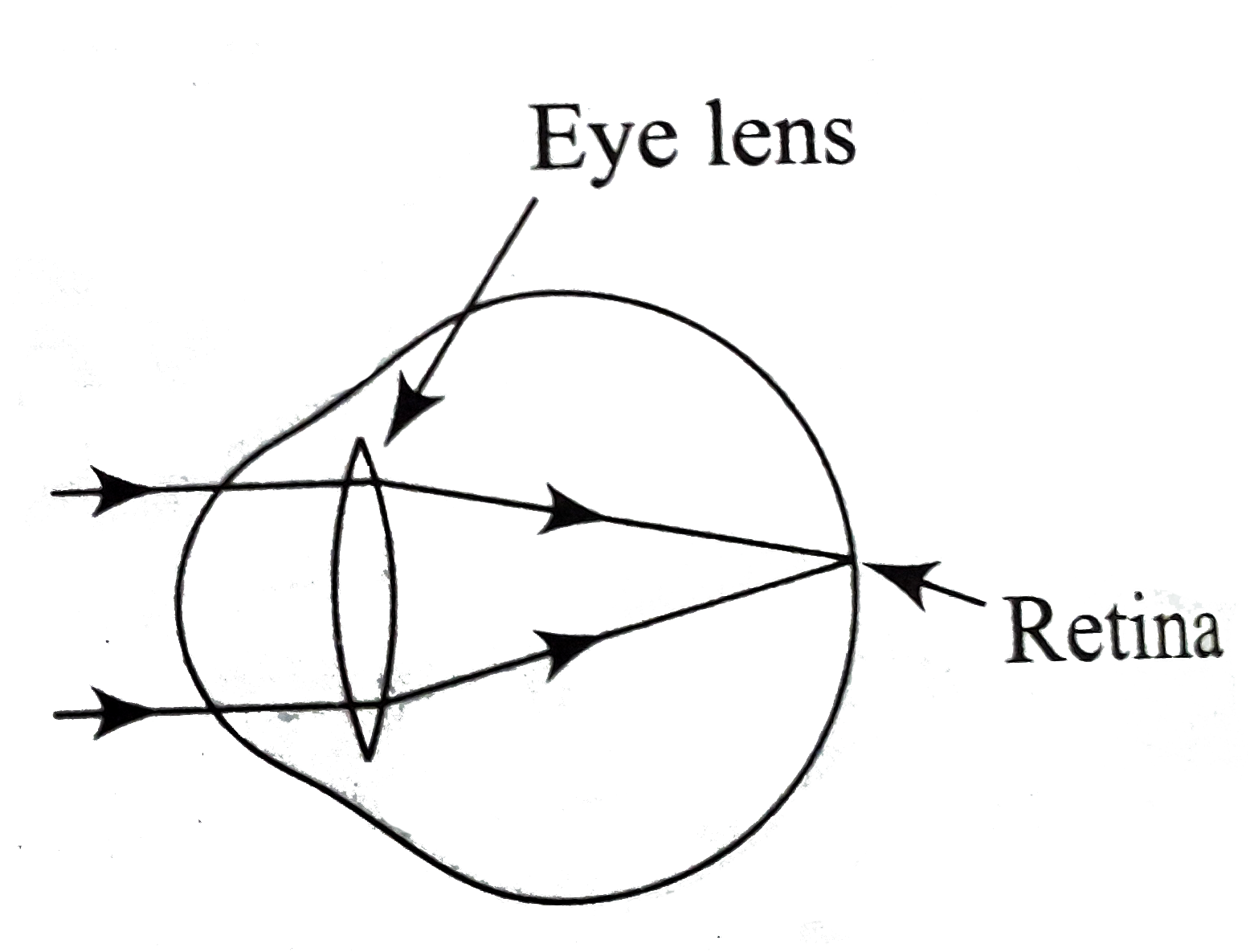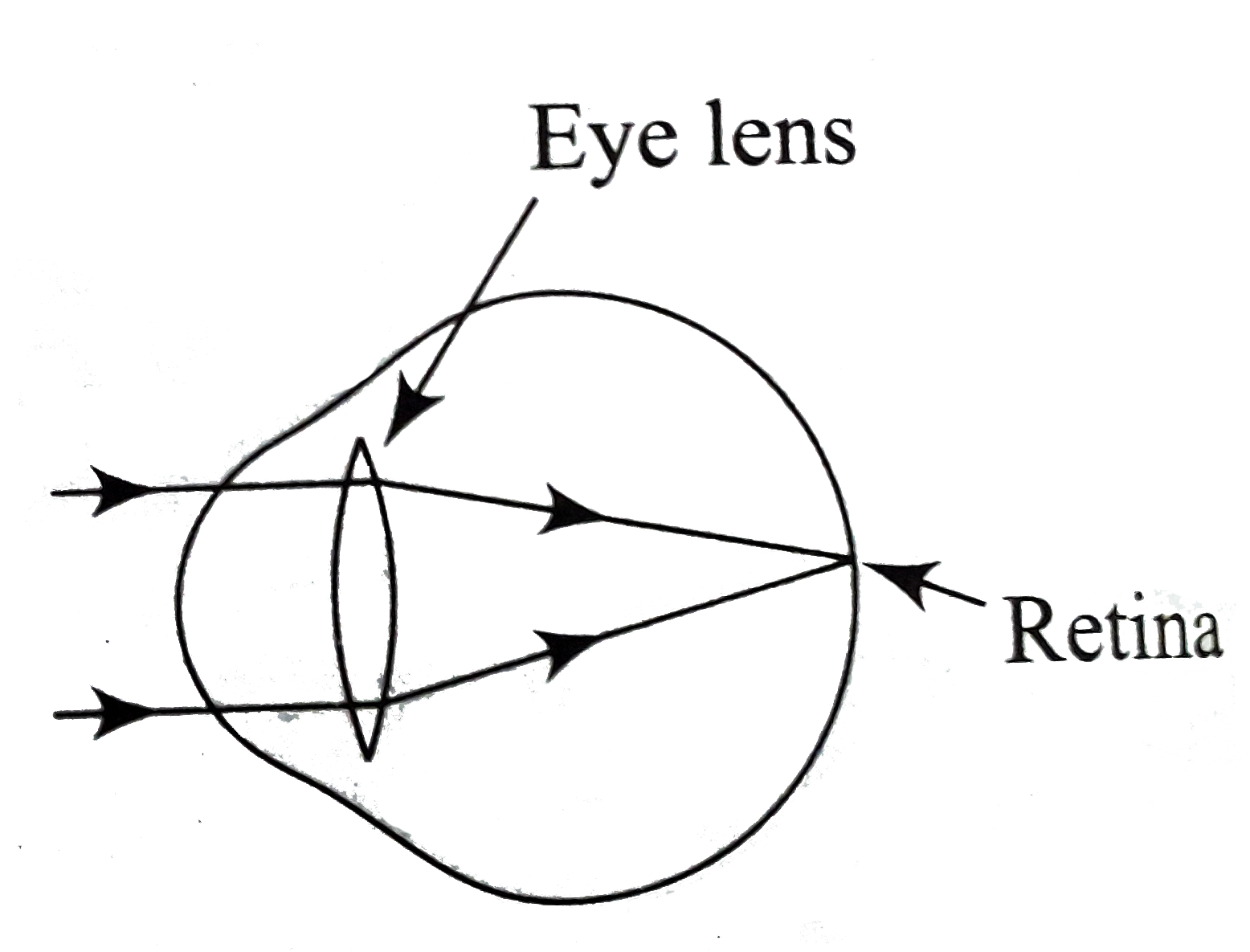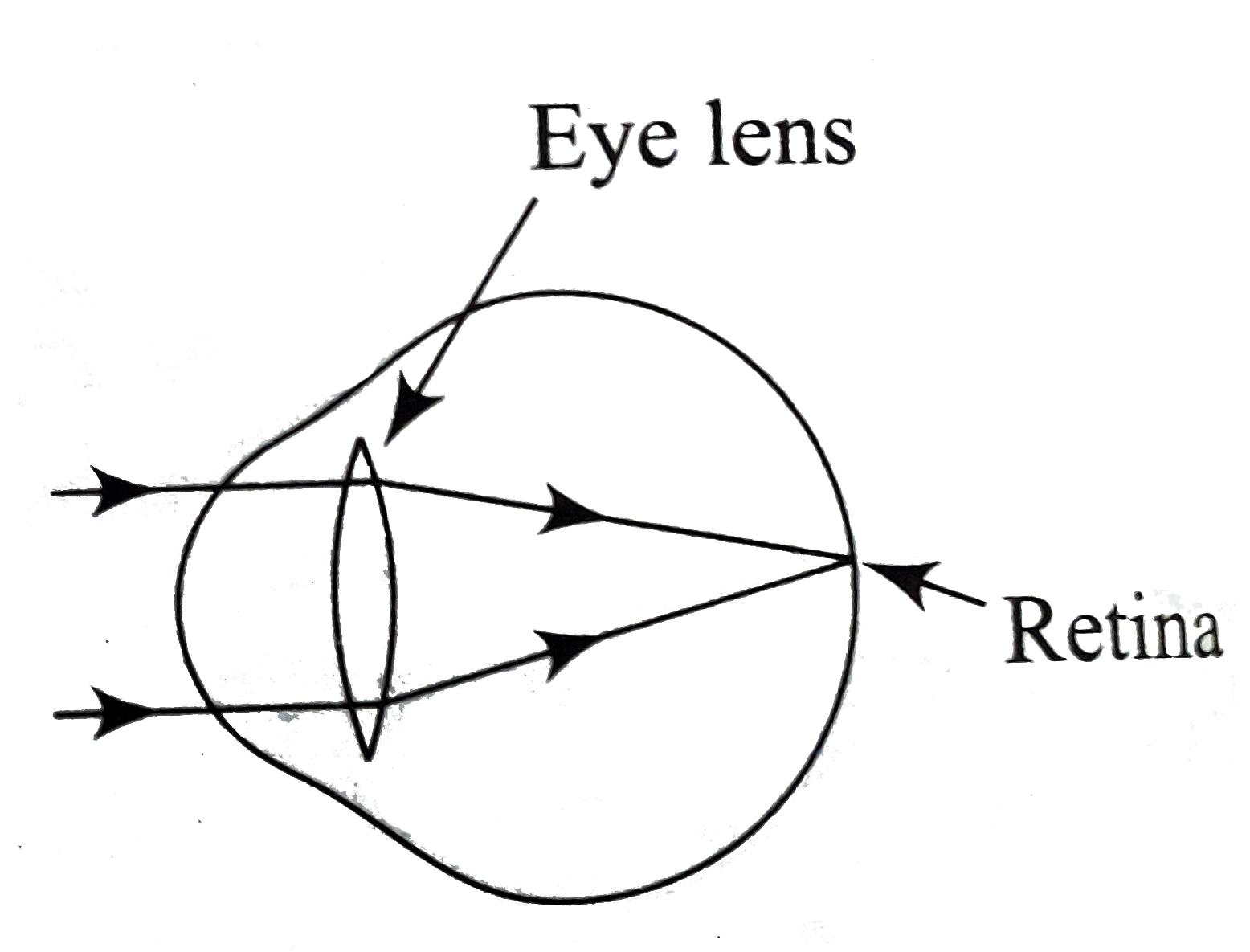[A] : Accomodation in the bird's eye is con- trolled by the ciliary apparatus.
[R]: It involves deformation of retina.
If both A and R are true and R is the correct explanation of A
If both A and R are true but R is not the correct explanation of A
If A is true and R is false
If both A and R are false
The correct Answer is:C
Step-by-Step Solution:
1. Understanding Accommodation:
- Accommodation is the process by which the eye adjusts its optical power to focus on objects at different distances. This is crucial for clear vision.
2. Role of the Ciliary Apparatus:
- In birds, as well as in other vertebrates, the ciliary apparatus (or ciliary body) plays a key role in accommodation. It contains muscles that control the shape of the lens. When these muscles contract or relax, they change the curvature of the lens, allowing the eye to focus light properly on the retina.
3. Function of the Retina:
- The retina is the light-sensitive layer at the back of the eye where images are formed. For clear vision, light must be focused on the retina. If the light does not fall on the retina correctly, vision will be impaired.
4. Evaluating the Statements:
- Statement (A): "Accommodation in the bird's eye is controlled by the ciliary apparatus."
- This statement is true because the ciliary muscles adjust the lens shape for focusing.
- Statement (R): "It involves deformation of the retina."
- This statement is false. Accommodation does not involve the deformation of the retina; rather, it is about adjusting the lens to focus light correctly on the retina.
5. Conclusion:
- Therefore, we conclude that statement (A) is true and statement (R) is false.
- Accommodation is the process by which the eye adjusts its optical power to focus on objects at different distances. This is crucial for clear vision.
- In birds, as well as in other vertebrates, the ciliary apparatus (or ciliary body) plays a key role in accommodation. It contains muscles that control the shape of the lens. When these muscles contract or relax, they change the curvature of the lens, allowing the eye to focus light properly on the retina.
- The retina is the light-sensitive layer at the back of the eye where images are formed. For clear vision, light must be focused on the retina. If the light does not fall on the retina correctly, vision will be impaired.
- Statement (A): "Accommodation in the bird's eye is controlled by the ciliary apparatus."
- This statement is true because the ciliary muscles adjust the lens shape for focusing.
- Statement (R): "It involves deformation of the retina."
- This statement is false. Accommodation does not involve the deformation of the retina; rather, it is about adjusting the lens to focus light correctly on the retina.
- Therefore, we conclude that statement (A) is true and statement (R) is false.
Topper's Solved these Questions
Similar Questions
[A]: During ovarian cycle follicles are con- trolled by gonadotropic hormones, follicle stimulating hormone (FSH) and luteinizing hormone (LH).
[R]: During ovarian cycle follicles undergo maturation, contain a secondary oocyte and produce female sex hormones.
View Solution[A]: The evolution of molecular oxygen is con- cerned with photosystem-1 (PSI).
[R]: The photosystem-11 (PS-II) is not involved in the evolution of oxygen.
View Solution[A]: The evolution of molecular oxygen is con- cerned with photosystem-1 (PS-I).
[R]: The photosystem-11 (PS-II) is not involved in the evolution of oxygen
View SolutionA myopic adult has a far point at 0.1m. His power of accomodation is 4 diopters.
(i) What power lenses are required to see distant objects ?
(ii) What is his near point without glasses ?
(iii) What is his near point with glasses ? (Take the image distance from the lens of the eye to the retina to be 2 cm).
View SolutionDraw a diagram of the vertical section of human eye and label the following parts : (i) cornea, (ii) iris, (iii) aqueous humour, (iv) retina, (v) ciliary body, (vi) fovea centralis, (vii) choroid, (viii) pupil, and (ix) lens.
View SolutionA : In a movie ordinary 24 frames are projected per second from one end to the other of the complete film.
R : The image formed on the retina of the eye is sustained upto (1/10)s after the removed of the stimulus.
View SolutionThe ciliary muscles of eye control the curvature of the lens in the eye and hence can alter the effective focal length of the system. When the muscles are fully relaxed, the focal length is maximum. When the muscles are strained, the curvature of lens increases. That means radius of curvature decreases and focal length decreases. For a clear vision, the image must be on the retina. The image distance is therefore fixed for clear vision and it equals the distance of retina from eye lens. It is about 2.5cm for a grown up person.
A perosn can theoretically have clear vision of an object situated at any large distance from the eye. The smallest distance at which a person can clearly see is related to minimum possible focal length. The ciliary muscles are most strained in this position. For an average grown up person, minimum distance of the object should be around 25cm.
A person suffering from eye defects uses spectacles (eye glass). The function of lens of spectacles is to form the image of the objects within the range in which the person can see clearly. The image o the spectacle lens becomes object for the eye lens and whose image is formed on the retina.
The number of spectacle lens used for th eremedy of eye defect is decided by the power fo the lens required and the number of spectacle lens is equal to the numerical value of the power of lens with sign. For example, if power of the lens required is +3D (converging lens of focal length 100/3cm ), then number of lens will be +3.
For all the calculations required, you can use the lens formula and lensmaker's formula. Assume that the eye lens is equiconvex lens. Neglect the distance between the eye lens and the spectacle lens.

Q. Minimum focal length of eye lens of a normal peson is
View SolutionThe ciliary muscles of eye control the curvature of the lens in the eye and hence can alter the effective focal length of the system. When the muscles are fully relaxed, the focal length is maximum. When the muscles are strained, the curvature of lens increases. That means radius of curvature decreases and focal length decreases. For a clear vision, the image must be on the retina. The image distance is therefore fixed for clear vision and it equals the distance of retina from eye lens. It is about 2.5cm for a grown up person.
A perosn can theoretically have clear vision of an object situated at any large distance from the eye. The smallest distance at which a person can clearly see is related to minimum possible focal length. The ciliary muscles are most strained in this position. For an average grown up person, minimum distance of the object should be around 25cm.
A person suffering from eye defects uses spectacles (eye glass). The function of lens of spectacles is to form the image of the objects within the range in which the person can see clearly. The image o the spectacle lens becomes object for the eye lens and whose image is formed on the retina.
The number of spectacle lens used for th eremedy of eye defect is decided by the power fo the lens required and the number of spectacle lens is equal to the numerical value of the power of lens with sign. For example, if power of the lens required is +3D (converging lens of focal length 100/3cm ), then number of lens will be +3.
For all the calculations required, you can use the lens formula and lensmaker's formula. Assume that the eye lens is equiconvex lens. Neglect the distance between the eye lens and the spectacle lens.

Q. Maximum focal length of a eye lens of a normal person is
View SolutionThe ciliary muscles of eye control the curvature of the lens in the eye and hence can alter the effective focal length of the system. When the muscles are fully relaxed, the focal length is maximum. When the muscles are strained, the curvature of lens increases. That means radius of curvature decreases and focal length decreases. For a clear vision, the image must be on the retina. The image distance is therefore fixed for clear vision and it equals the distance of retina from eye lens. It is about 2.5cm for a grown up person.
A perosn can theoretically have clear vision of an object situated at any large distance from the eye. The smallest distance at which a person can clearly see is related to minimum possible focal length. The ciliary muscles are most strained in this position. For an average grown up person, minimum distance of the object should be around 25cm.
A person suffering from eye defects uses spectacles (eye glass). The function of lens of spectacles is to form the image of the objects within the range in which the person can see clearly. The image o the spectacle lens becomes object for the eye lens and whose image is formed on the retina.
The number of spectacle lens used for th eremedy of eye defect is decided by the power fo the lens required and the number of spectacle lens is equal to the numerical value of the power of lens with sign. For example, if power of the lens required is +3D (converging lens of focal length 100/3cm ), then number of lens will be +3.
For all the calculations required, you can use the lens formula and lensmaker's formula. Assume that the eye lens is equiconvex lens. Neglect the distance between the eye lens and the spectacle lens.

Q. A far sighted man connot see objects clearly unless they are at least 100cm from his eyes. The number of the spectacle lenses that will make his range of clear vision equal to an average grown up person will be
View SolutionThe ciliary muscles of eye control the curvature of the lens in the eye and hence can alter the effective focal length of the system. When the muscles are fully relaxed, the focal length is maximum. When the muscles are strained, the curvature of lens increases. That means radius of curvature decreases and focal length decreases. For a clear vision, the image must be on the retina. The image distance is therefore fixed for clear vision and it equals the distance of retina from eye lens. It is about 2.5cm for a grown up person.
A perosn can theoretically have clear vision of an object situated at any large distance from the eye. The smallest distance at which a person can clearly see is related to minimum possible focal length. The ciliary muscles are most strained in this position. For an average grown up person, minimum distance of the object should be around 25cm.
A person suffering from eye defects uses spectacles (eye glass). The function of lens of spectacles is to form the image of the objects within the range in which the person can see clearly. The image o the spectacle lens becomes object for the eye lens and whose image is formed on the retina.
The number of spectacle lens used for th eremedy of eye defect is decided by the power fo the lens required and the number of spectacle lens is equal to the numerical value of the power of lens with sign. For example, if power of the lens required is +3D (converging lens of focal length 100/3cm ), then number of lens will be +3.
For all the calculations required, you can use the lens formula and lensmaker's formula. Assume that the eye lens is equiconvex lens. Neglect the distance between the eye lens and the spectacle lens.

Q. A near sighted man can clearly see ojects only upto a distance of 100cm and not beyond this. The number of the spectacle lenses necessary for the remedy of this defect will be
View Solution
